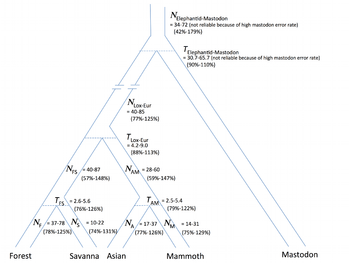Elephantidae
The Elephantidae are a family of large, herbivorous mammals collectively called elephants and mammoths. These are terrestrial large mammals with a snout modified into a trunk and teeth modified into tusks. Most genera and species in the family are extinct. Only two genera, Loxodonta (African elephants) and Elephas (Asiatic elephants), are living.
| Elephantidae | |
|---|---|
.jpg) | |
| A male Asian elephant (Elephas maximus) in the wild at Bandipur National Park in India | |
| Scientific classification | |
| Kingdom: | Animalia |
| Phylum: | Chordata |
| Class: | Mammalia |
| Order: | Proboscidea |
| Superfamily: | Elephantoidea |
| Family: | Elephantidae Gray, 1821 |
| Type genus | |
| Elephas | |
| Subgroups[1] | |
| |
| Synonyms[2] | |
| |
The family was first described by John Edward Gray in 1821,[3] and later assigned to taxonomic ranks within the order Proboscidea. The Elephantidae have also been revised by various authors to include or exclude other extinct proboscidean genera.
Classification

Scientific classification of Elephantidae taxa embraces an extensive record of fossil specimens, over millions of years, some of which existed until the end of the last ice age. Some species were extirpated more recently. The discovery of new specimens and proposed cladistics have resulted in systematic revisions of the family and related proboscideans.
Elephantids are classified informally as the elephant family, or in a paleobiological context as elephants and mammoths. The common name elephant primarily refers to the living taxa, the modern elephants, but may also refer to a variety of extinct species, both within this family and in others. Other members of the Elephantidae, especially members of Mammuthus, are referred to by the common name mammoth.
The family diverged from a common ancestor of the mastodons of Mammutidae. The classification of proboscideans is unstable and has been frequently revised.
The following cladogram shows the placement of the genus Mammuthus among other proboscideans, based on hyoid characteristics:[1]
| Elephantidae |
| |||||||||||||||||||||||||||||||||

The systematics of the living subspecies and species of the modern elephants has undergone several revisions. A list of the extant Elephantidae includes:[4]
- Elephantidae
- Loxodonta (African)
- L. africana African bush elephant
- L. a. pharaoensis North African elephant†
- L. cyclotis African forest elephant
- L. africana African bush elephant
- Elephas (Asiatic)
- E. maximus Asian elephant
- E. m. maximus Sri Lankan elephant
- E. m. indicus Indian elephant
- E. m. sumatranus Sumatran elephant
- E. m. borneensis Borneo elephant
- E. m. sondaicus Javan elephant†
- E. m. asurus Syrian elephant†
- E. maximus Asian elephant
- Loxodonta (African)
Evolutionary history

Although the fossil evidence is uncertain, by comparing genes, scientists have discovered evidence that elephantids and other proboscideans share a distant ancestry with Sirenia (sea cows) and Hyracoidea (hyraxes).[5] These have been assigned, along with the extinct demostylians and embrithopods, to the clade Paenungulata. In the distant past, members of the various hyrax families grew to large sizes, and the common ancestor of all three modern families is thought to have been some kind of amphibious hyracoid. One hypothesis is that these animals spent most of their time under water, using their trunks like snorkels for breathing.[6][7] Modern elephants have this ability and are known to swim in that manner for up to six hours and 50 km (31 mi).
In the past, a much wider variety of genera and species was found, including the mammoths and stegodons.[8][9]
See also
- Deinotherium
- Embrithopoda
- Eritherium azzouzorum
- Mammut borsoni
- Palaeoloxodon namadicus
References
- Shoshani, J.; Ferretti, M.P.; Lister, A.M.; Agenbroad, L.D.; Saegusa, H.; Mol, D.; Takahashi, K. (2007). "Relationships within the Elephantinae using hyoid characters". Quaternary International. 169-170: 174–185. Bibcode:2007QuInt.169..174S. doi:10.1016/j.quaint.2007.02.003.
- Maglio, Vincent J. (1973). "Origin and Evolution of the Elephantidae". Transactions of the American Philosophical Society. 63 (3): 16. JSTOR 1006229.
- Gray, John Edward (1821). "On the natural arrangement of vertebrose animals". London Medical Repository. 15: 297–310.
- Shoshani, J. (2005). "Order Proboscidea". In Wilson, D.E.; Reeder, D.M (eds.). Mammal Species of the World: A Taxonomic and Geographic Reference (3rd ed.). Johns Hopkins University Press. ISBN 978-0-8018-8221-0. OCLC 62265494.
- Ozawa, Tomowo; Hayashi, Seiji; Mikhelson, Victor M. (1997-04-24), "Phylogenetic Position of Mammoth and Steller's Sea Cow Within Tethytheria Demonstrated by Mitochondrial DNA Sequences", Journal of Molecular Evolution, 44 (4): 406–413, Bibcode:1997JMolE..44..406O, doi:10.1007/PL00006160, PMID 9089080
- West, John B. (2001), "Snorkel breathing in the elephant explains the unique anatomy of its pleura", Respiratory Physiology, 126 (1): 1–8, doi:10.1016/S0034-5687(01)00203-1, PMID 11311306
- West, John B.; Fu, Zhenxing; Gaeth, Ann P.; Short, Roger V. (2003-11-14), "Fetal lung development in the elephant reflects the adaptations required for snorkeling in adult life", Respiratory Physiology & Neurobiology, 138 (2–3): 325–333, doi:10.1016/S1569-9048(03)00199-X, PMID 14609520
- Todd, N. E. (2001). African Elephas recki: time, space and taxonomy Archived 2008-12-16 at the Wayback Machine (pdf). In: Cavarretta, G., P. Gioia, M. Mussi, and M. R. Palombo. The World of Elephants, Proceedings of the 1st International Congress. Consiglio Nazionale delle Ricerche. Rome, Italy.
- Todd, N. E. (2005). Reanalysis of African Elephas recki: implications for time, space and taxonomy. Quaternary International 126-128:65-72.
External links

